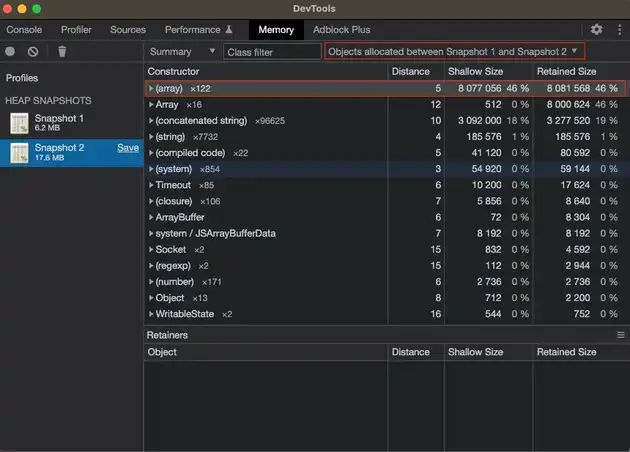Preface
首先,先科普一下,nodejs 是 single thread,儘管你的主機有複數顆 cpu(nodejs 可以透過os.cpus().length來查看),運行時,也只會使用到其中一個;但有些情況下,你的確需要使用複數個 cpu 來進行處理,這時你便需要使用到 cluster module 來進行處理,更細節的部分,可以參考該 youtube 教學,我認為解釋的相當不錯。
切回正題,所以當你運行的 nodejs 程式時,cpu 吃到 100%,就會導致程式執行緩慢,甚至無法正常運行,這時候你就需要找出問題所在,並解決它。
How to fix the problem
在寫 nodejs 時,為了讓某些參數能複用,所以時常會宣告一些參數在 function 外,下面是範例:
let interval = ReturnType<typeof setInterval>()
const DELAY_TIMEOUT_MS = 1000
function highCPUUsageFn() {
//...
}
export function startInterval() {
interval = setInterval(() => {
highCPUUsageFn()
}, DELAY_TIMEOUT_MS)
}
export function stopInterval() {
clearInterval(interval)
}假使你的程式在某些特殊情況,恰巧無法觸發 stopInterval 時,該 interval 便不會被 nodejs garbage collection 回收,若好死不死 interval 內又是一個需要跑迴圈很耗 cpu 的程式,那麼你的 cpu 就會被吃光光了,這種是滿常出現的情況。
第二種情況是,對程式較不理解,像是 Buffer:
let buffer = Buffer.alloc(0)
// while, for, or any other loop, websocket, etc.
for (let i = 0; i < 6000000; i++) {
buffer = Buffer.concat([buffer, Buffer.from("a")])
}這種情況也是不好的,因為 Buffer.concat 每次運行都是產生一個全新 buffer,當 buffer 的量越來越大或運行次數太過頻繁時,會造成 cpu 使用率過高,像是在處理音訊時,在這種情況我們可以先宣告一個比較大的 buffer ,接著將音訊的 buffer 依照各自的 offset 寫進去,會是一個比較好的方案:
const totalSize = 1024 * 1024 // Total size of the big buffer in bytes (1 MB in this example)
const chunkSize = 4096 // Size of each chunk in bytes
// Create a big buffer with the specified total size
const bigBuffer = Buffer.alloc(totalSize)
// Loop to assign 4096 size chunks into the big buffer
for (let offset = 0; offset < totalSize; offset += chunkSize) {
const chunk = Buffer.alloc(chunkSize)
// You can fill the chunk with data here if needed
// For example, you can use chunk.fill(0) to fill it with zeros, or copy data from another buffer
// Copy the chunk into the big buffer at the specified offset
chunk.copy(bigBuffer, offset)
// Write the chunk into the big buffer at the specified offset
// chunk.write(bigBuffer, offset);
}其實我個人滿推薦第三方套件來處理 Buffer,相當不錯的一個套件是 bl,它可以幫你處理 buffer 上的問題,底層是使用 array 來貯存 Buffer,相比於上面的方法,我認為更為簡潔:
import { BufferList } from "bl"
const bl = new BufferList()
// while, for, or any other loop, websocket, etc.
for (let i = 0; i < 6000000; i++) {
// 沒錯就是簡簡單單的 append,不會有每次都產生新的 buffer 的問題,也不需要自己處理 offset
bl.append(Buffer.from("a"))
}
bl.slice(0, 100) // 可以直接使用 slice 來取得 buffer第三種情況則是,使用的套件有問題,這種情況就必須等待你使用的套件維護者有在持續維護該套件了,發 PR,或是你可以自己 fork 出來,自己維護,這種情況就相對比較麻煩了。
當然還有其他情況,像是其實你有運行 callback,但是你忘記讓 callback return 之類的,導致程式一直往下執行,亦或著其他服務因為某些原因掛掉,你程式又有 await 該服務,服務會 hang 住,此時如果程式又一直接收的話,event 就會囤起來,最終導致 cpu 使用率過高…等的使用情境,這些都是需要特別注意的地方。
How to detect the problem
要如何較快速的找到是哪裡出現問題,首先會先用 htop 確認,是否的的確確是 nodejs cpu 吃到很高,如果是,接著我個人會使用 node inspect 搭配 chrome inspect 來尋找程式上面的瑕疵。
// package.json
{
"script": {
"watch": "tsc -w",
"dev": "nodemon --delay 500ms dist/index.js",
"dev:inspect": "nodemon --inspect=0.0.0.0:9229 --delay 500ms dist/index.js",
"start": "concurrently \"npm run watch\" \"npm run dev\"",
"start:inspect": "concurrently \"npm run watch\" \"npm run dev:inspect\""
}
}接著使用 snapshot 的功能,判別兩張 snapshot 之間的差異,圖片是從這篇 Medium 文章 上面拿的,僅是示意而已:

Conclusion
其實我自己實際遇到的情況是 Buffer.concat 的太過頻繁,導致 cpu 使用率過高,後來使用 bl 套件來解決掉了。坦白說,這種有時很難發現,因為我在這前一版本也是直接使用 Buffer.concat,卻沒有發生任何問題,新版本所新增的功能,我也不認為會導致高 cpu 這種情況,但是確實是發生了,有點弔詭,可能還是要持續觀察。
我個人目前還是覺得 nodejs 提供 debug 的方式還是相對不太友善,儘管已搭配 Typescript 強型別,eslint…等輔助,但是在 memory debug 上還是頗為困難,期許後面有人能開發更有效率的 debug 工具。
推一下 Rust,由於 Rust 語言的特性,在 debug 上面就相當的友善,宣告的不對,或是沒清掉,甚至連跑都沒辦法跑,難怪近期深受許多工程師推崇。